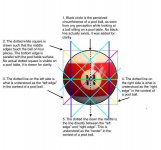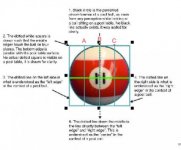Below are a couple pics of cut shots, in the first one, the three ball, not a drawings on a flat piece of paper. The pics shows depth and curves of the balls. plus both balls needed to do a shot. Plus it also shows the point of view of the shots.
Notice how they do not appear flat like a drawing on a piece of paper. You are also looking down at a angle from a standing position and not from a straight on view like looking at a piece of paper.
I've mentioned offset before. Using these pic, what I mean is that the contact point is offset to the CB direction of travel line to where the CB needs to be to pocket the ball.
So when someone says they look at the contact point on the object ball or even at the OB, this means that their eyes are not looking at where the CB needs to be to pocket the ball. If looking at the contact point or the 3 ball itself, on this shot,this means the eyes are looking to the left of where the CB needs to be to pocket the ball.
As the cut angle increases, this offset becomes greater which means that if they are looking at the OB or its contact point on a high degree cut shot, the distance to where the CB needs to be to pocket the ball is greater.
This also means the the contact point on the CB is gonna be offset to the CB direction of travel of line. So now you are aligning two points offset to CB direction of travel line.
Also, as CB to OB distance increases is in the second pic, trying to aligning two contacts, one being in the back side of the CB, looking at the contact point on the OB which is not where the CB needs to be to pocket the ball is very challenging more so than trying to place the CB where it needs with contact patch.
With contact patch, your eyes are always on where the CB needs to be. They never need to look at the OB once you pick the spot on the table.
With contact patch, you are trying to roll the bottom of the CB, ie place, over the spot on the table that pockets the ball, not trying to have some point on the CB hit some point on the OB. And as Ive mentioned before, the top of the CB is 180 from the contact patch, so the top can be used to sight the shot where the CB needs to be to pocket the ball. Using the arrow, you can sight the top of the CB to the arrow's point. That is the closet thing to real aiming in pool.
Also, using the arrow, you could place your cue tip on the arrow and rotate it until the center of the cue is over the top of the CB in order to get a reference for the CB direction of travel.
Contact patch is way simpler and easier to use than CTE. Contact patch concerns itself with only one line not multiple ones. Contact patch only line of concern is the direction of travel of the CB. No need for multiple DVD's, Youtubes nor a text book style manual or personal lessons.
Just my simple little drawing and Babe Cranfields arrow to train with and your good to go......all can be had for free.
There is no simpler, easier way to learn pool than ghost ball contact patch.
Oh yeah, how come no one else uses real world pics of shots as examples? Really......come on, take a pic from the standing position and using a photo editing software, add all those nice little that are shown in 2d and if CTE users "see" lines in their mind, than those lines should be able to be added to the photo.

